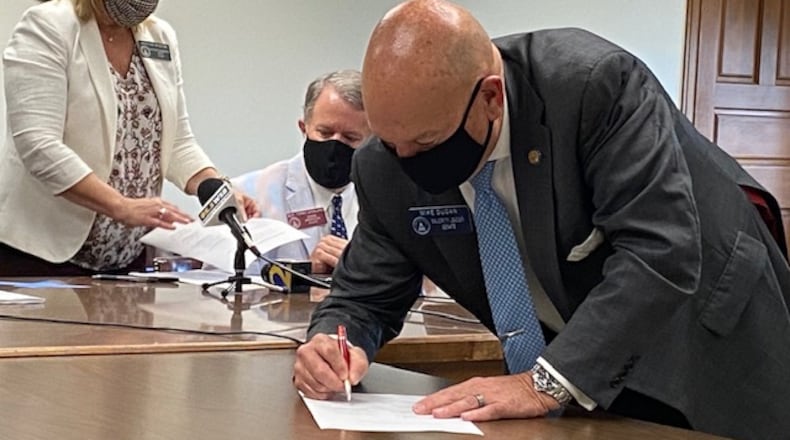Georgia House and Senate leaders agreed Thursday on a final budget for the upcoming fiscal year that cuts $950 million in basic k-12 school funding but doesn’t force state agencies to furlough staffers.
That is big news for tens of thousands of state workers, some of whom were expecting to have to take weeks off without getting paid. Whether there are still furloughs next year in the University System of Georgia will be up to the Board of Regents.
Budget writers also said most school systems have reserves and federal money to help make up for state funding cuts.
The $26 billion spending plan for fiscal 2021 — which begins Wednesday — would cut spending by $2.2 billion to meet the expected decline in revenue due to the coronavirus recession.
But budget writers eliminated or mitigated some of the most talked about proposed reductions — including furloughs for tens of thousands of state employees, such as state patrolmen and public health workers who have spent the past three months battling the pandemic.
They also lessened some of the cuts to public and mental health, autism and substance abuse programs, areas particularly hard hit by earlier budget plans. Proposed cuts to doctor training programs were eliminated, and some vacant positions slated to be axed, such as those for lab scientists in the Georgia Bureau of Investigation, would be given the green light to be filled.
House Appropriations Chairman Terry England, R-Auburn, said Gov. Brian Kemp's recent estimate — which showed the revenue drop wouldn't be quite as bad as earlier expected — allowed budget writers to avoid asking employees to take days off without pay.
Lawmakers and agencies had originally planned for 14% cuts, but Kemp reduced the figure to 10% this week. He also agreed to pour about $250 million in reserve funds into the state budget. That helped mitigate what agencies had to cut.
The difference between the 14% cut originally proposed and 10% is about $1 billion.
The pandemic brought record unemployment, and thousands of businesses either closed or still struggle to remain open. That, in turn, has sent state tax collections — mostly for income and sales taxes — plummeting.
Because the state expects less revenue, lawmakers have faced cutting funding for everything from k-12 schools and universities to the GBI, food safety inspections, highway construction, mental health and substance abuse programs, and county health departments.
Senate Minority Leader Steve Henson, D-Stone Mountain, said some of the cuts in the budget were due to poor decisions lawmakers have made in the past to lower taxes — like a reduction in the state income tax rate approved in 2018. That left the state without enough money to fully fund services, he said.
“The tax cuts of the past have put us in a vulnerable position,” Henson told colleagues. “Many of us are frustrated at this budget because we asked you to look at some of the tax exemptions to special-interest groups.”
Some Senate Republicans did look at trimming special-interest tax breaks, but House Speaker David Ralston, R-Blue Ridge, has made it clear his chamber wouldn't consider such reductions, saying doing so would be a "job killer."
The state spends more than half of its tax money on schools — k-12, universities and technical colleges.
While basic k-12 school funding would be cut $950 million, programs designed to provide more money for low-wealth districts would increase. The budget also would not cut pupil transportation funding.
Still, some school districts — particularly in rural areas with little property tax base — may face tough decisions. During the Great Recession, some of them laid off and furloughed teachers, eliminated programs and shortened the school year.
“Our Legislature had the opportunity to spread the sacrifice around and look at ways to increase revenue, but instead they again decided to balance the budget on the backs of our children’s’ education,” said John Palmer, a Cobb County educator and spokesman for the teacher group TRAGIC.
“This senior class will graduate having endured over $10 billion in austerity cuts,” Palmer said. “They deserve better from our Legislature.”
But House Speaker Pro Tem Jan Jones, R-Milton, said most school systems have built healthy reserves in recent years. And schools also received more than $400 million from the federal government when the CARES Act passed at the start of the pandemic, officials said.
“I do not expect students throughout Georgia to even know we had such a (state) reduction,” Jones said.
England said he would be disappointed to see districts furlough teachers.
“These are local decisions. They will have to deal with them the best they can,” he said. “There should be no (school) system at this point doing furloughs.”
Budget writers also eliminated plans to cut grants to county health departments, and they funded the extension of Medicaid to low-income mothers from two months to six months after giving birth, said Senate Appropriations Chairman Blake Tillery, R-Vidalia.
Doctors say that period is when conditions such as postpartum depression and high blood pressure, when left untreated, can be fatal to new moms. Georgia’s maternal mortality rate has long ranked among the bottom of U.S. states, and a bipartisan state study committee recently found that 60% of the state’s maternal deaths between 2012 and 2014 were preventable.
Lawmakers also chose not to cut $1 million from the public defender system’s appellate office, averting what some lawyers predicted would have led to litigation against the state over the right to counsel.
Members of the General Assembly would see their $17,000 salaries cut 10% this year under the spending plan, and Lt. Gov. Geoff Duncan’s $90,000 salary would drop 14%. The budget also would cut salary money for those making more than $100,000 a year in some judicial budgets.
Kemp asked budget writers to include $15 million to establish a grant program to pay for better training for state and local law enforcement, and $2.47 million for a new state trooper class in the upcoming year.
The governor also recommended lawmakers approve borrowing an additional $139 million for maintenance and repair work at state facilities, state-owned railroads and bridges to address infrastructure needs.
The budget includes about $1.13 billion in borrowing for construction projects, much of it for schools and colleges.
About the Author
Keep Reading
The Latest
Featured





